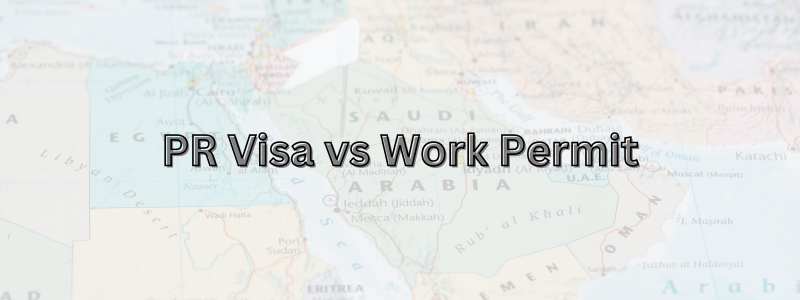When considering international travel for work or settlement, it is important to understand the differences between a Permanent Residency (PR) visa and a Work Permit. These two types of visas serve distinct purposes and offer different benefits and limitations. This article explains the key differences between Permanent resident visas (PR) and work permits and the implications for individuals seeking to live or work in a foreign country.
Table of Contents:
1. What is a Permanent Residency (PR) Visa?
2. What is a Work Permit?
3. Differences between PR Visa and Work Permit
3.1 Duration
3.2 Purpose
3.3 Eligibility
3.4 Job Flexibility
3.5 Citizenship Benefits
3.6 Social Benefits
3.7 Travel Restrictions
3.8 Family Sponsorship
4. Comparison of PR Visa Vs Work Permit
5. Summary
-
What is a Permanent Resident (PR) Visa?
A Permanent Resident (PR) visa is a type of visa that grants individuals the right to live and settle permanently in a foreign country. It is for individuals who wish to establish a long-term residence, potentially leading to citizenship.
Countries that provide Permanent resident visas follow a points-based system or other criteria that evaluate an individual's skills, qualifications, language proficiency, work experience, and adaptability.
Once granted, Permanent resident visa holders have the freedom to live, work, and study in the country of their choice without time restrictions.
They often enjoy access to social benefits, such as healthcare, education, and welfare programs. Permanent resident (PR) visas also offer a pathway to citizenship, allowing individuals to eventually apply for full citizenship rights and privileges.
-
What is a Work Permit?
A work permit, also known as a work visa, is a temporary authorization that allows foreign individuals to work legally in a foreign country for a specific period.
It is typically tied to a specific job offer from an employer in the host country.
Work permits are issued to address labour shortages or meet specific employment needs that cannot be filled by the local workforce.
To be eligible for a work permit, it is necessary to have a job offer from an employer who is willing to support and sponsor the applicant.
Work permits have a limited duration and are issued exclusively for the particular job or occupation for which they were granted. In other words, work permits are tied to a specific employment opportunity, and individuals can work legally only in that particular job as stated in the work permit.
While working in the host country, individuals with work permits may have limited access to social benefits and may be subject to certain travel restrictions.
-
8 Differences between Work Permit and Permanent Residency (PR) Visa
In summary, the key differences between PR visas and work permits include:
1. Duration:
PR visas offer long-term or indefinite permission to reside in a country, while work permits are temporary and have a specific validity period.
2. Purpose:
PR visas focus on settlement and citizenship, whereas work permits are primarily issued for employment purposes.
3. Eligibility:
PR visas are often based on a points-based system, while work permits require a job offer or sponsorship from an employer.
4. Job Flexibility:
PR visa holders have the flexibility to work for any employer, whereas work permit holders are generally limited to a specific employer or job.
5. Citizenship Benefits:
PR visa holders have a direct pathway to citizenship, while work permits do not offer a direct route to citizenship.
6. Social Benefits:
PR visa holders usually have access to a wide range of social benefits, while work permit holders may have limited access to such benefits.
7. Travel Restrictions:
PR visa holders face fewer travel restrictions compared to work permit holders, who may be restricted to work-related travel.
8. Family Sponsorship:
PR visa holders are often eligible to sponsor their family members, while work permit holders may have limited or no family sponsorship options.
-
Comparison of PR Visa Vs Work Permit
Now, let's take a closer look at the table that compares the differences between pr visa and a work permit as we discussed earlier:
|
Factors |
Permanent Residency Visa (PR) |
Work Permit |
|
Duration |
Long-term or indefinite |
Temporary |
|
Purpose |
Settlement and citizenship |
Employment |
|
Eligibility |
Points-based system |
Job offer or sponsorship |
|
Job Flexibility |
Open to any employer |
Limited to a specific employer |
|
Citizenship Benefits |
Eligible for Citizenship |
No direct path to citizenship |
|
Social Benefits |
Access to social services |
Limited access to benefits |
|
Travel Restrictions |
Fewer travel restrictions |
Restricted to work-related trips |
|
Family Sponsorship |
Eligible to sponsor family |
Limited or no family sponsorship |
Summary:
In summary, Permanent Resident visas and Work Permits differ in terms of their duration, purpose, eligibility criteria, job flexibility, citizenship benefits, social benefits, travel restrictions, and family sponsorship options.
PR visas provide long-term or indefinite permission to reside in a country, with the aim of settlement and eventual citizenship. Work permits, on the other hand, are temporary authorizations tied to specific job offers and focus on employment needs.
While PR visa holders enjoy more job flexibility, social benefits, and a pathway to citizenship, work permit holders have limited job flexibility and access to social benefits.
It is crucial to consult the specific regulations and policies of the target country to obtain the most accurate and up-to-date information regarding PR visas and work permits.






.jpg)








